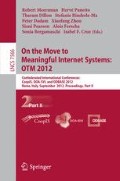Abstract
Business Intelligence (BI) offers great opportunities for strategic analysis of current and future business operations; however, existing BI tools typically provide data-oriented responses to queries, difficult to understand in terms of business objectives and strategies. To make BI data meaningful, we need a conceptual modeling language whose primitive concepts represent business objectives, processes, opportunities and threats. We have previously introduced such a language, the Business Intelligence Model (BIM). In this paper we consolidate and rationalize earlier work on BIM, giving a precise syntax, reducing the number of fundamental concepts by using meta-attributes, and introducing the novel notion of “pursuit”. Significantly, we also provide a formal semantics of BIM using a subset of the OWL Description Logic (DL). Using this semantics as a translation, DL reasoners can be exploited to (1) propagate evidence and goal pursuit in support of “what if?” reasoning, (2) allow extensions to the BIM language, (3) detect inconsistencies in specific BIM models, and (4) automatically classify defined concepts relative to existing concepts, organizing the model.
Access this chapter
Tax calculation will be finalised at checkout
Purchases are for personal use only
Preview
Unable to display preview. Download preview PDF.
References
Object Management Group, Business Process Modeling Notation (BPMN) Version 2.0 (2009), http://www.omg.org/spec/BPMN/2.0
Kaplan, R.S., Norton, D.P.: Strategy Maps: Converting Intangible Assets into Tangible Outcomes, pp. 1–4. Harvard Business School Press (September 2004)
Kaplan, R.S., Norton, D.P.: Balanced Scorecard: Translating Strategy into Action. Harvard Business School Press (1996)
Dealtry, T.R.: Dynamic SWOT Analysis. Dynamic SWOT Associates (1994)
Yu, E.: Towards modelling and reasoning support for early-phase requirements engineering. In: Proceedings of 3rd IEEE International Symposium on Requirements Engineering (RE 1997), vol. 97, pp. 226–235 (1997)
Dardenne, A., Lamsweerde, A.V., Fickas, S.: Goal-directed requirements acquisition. Science of Computer Programming 20(1-2), 3–50 (1993)
W3C, OWL 2 Web Ontology Language Manchester Syntax (2009), http://www.w3.org/TR/owl2-manchester-syntax/
Jiang, L., Barone, D., Amyot, D., Mylopoulos, J.: Strategic Models for Business Intelligence. In: Jeusfeld, M., Delcambre, L., Ling, T.-W. (eds.) ER 2011. LNCS, vol. 6998, pp. 429–439. Springer, Heidelberg (2011)
Barone, D., Jiang, L., Amyot, D., Mylopoulos, J.: Composite Indicators for Business Intelligence. In: Jeusfeld, M., Delcambre, L., Ling, T.-W. (eds.) ER 2011. LNCS, vol. 6998, pp. 448–458. Springer, Heidelberg (2011)
Barone, D., Yu, E., Won, J., Jiang, L., Mylopoulos, J.: Enterprise Modeling for Business Intelligence. In: van Bommel, P., Hoppenbrouwers, S., Overbeek, S., Proper, E., Barjis, J. (eds.) PoEM 2010. LNBIP, vol. 68, pp. 31–45. Springer, Heidelberg (2010)
Barone, D., Jiang, L., Amyot, D., Mylopoulos, J.: Reasoning with Key Performance Indicators. In: Johannesson, P., Krogstie, J., Opdahl, A.L. (eds.) PoEM 2011. LNBIP, vol. 92, pp. 82–96. Springer, Heidelberg (2011)
Borgida, A., Horkoff, J., Mylopoulos, J., Rosati, R.: Experiences in Mapping the Business Intelligence Model to Description Logics, and the Case for Parametric Concepts. In: Proceedings of the 2012 International Workshop on Description Logics, DL 2012 (2012)
Datamonitor, Global Credit & Charge Cards Industry Profile (2004)
Giorgini, P., Mylopoulos, J., Nicchiarelli, E., Sebastiani, R.: Formal Reasoning Techniques for Goal Models. In: Spaccapietra, S., March, S., Aberer, K. (eds.) Journal on Data Semantics I. LNCS, vol. 2800, pp. 1–20. Springer, Heidelberg (2003)
Sebastiani, R., Giorgini, P., Mylopoulos, J.: Simple and Minimum-Cost Satisfiability for Goal Models. In: Persson, A., Stirna, J. (eds.) CAiSE 2004. LNCS, vol. 3084, pp. 20–35. Springer, Heidelberg (2004)
Amyot, D., Ghanavati, S., Horkoff, J., Mussbacher, G., Peyton, L., Yu, E.: Evaluating goal models within the goal-oriented requirement language. International Journal of Intelligent Systems 25(8), 841–877 (2010)
Berardi, D., Calvanese, D., Degiacomo, G.: Reasoning on UML class diagrams. Artificial Intelligence 168(1-2), 70–118 (2005)
Wetzel, T.: States of Affairs. The Stanford Encyclopedia of Philosophy, Fall 2008 Edition (2008), http://plato.stanford.edu/archives/fall2008/entries/states-of-affairs
Masolo, C., Borgo, S., Gangemi, A., Guarino, N., Oltramari, A.: WonderWeb Deliverable D18. The WonderWeb Library of Foundational Ontologies and the DOLCE ontology (December 2003)
Krötzsch, M., Rudolph, S., Hitzler, P.: Description Logic Rules. In: Proceedings of the 18th European Conference on Artificial Intelligence (ECAI 2008), pp. 80–84 (2008)
Opdahl, A.L., Berio, G., Harzallah, M., Matulevicius, R.: An ontology for enterprise and information systems modelling. Applied Ontology 7(1), 49–92 (2012)
Du, J., Pan, J.Z.: Towards Practical ABox Abduction in Large OWL DL Ontologies. In: Artificial Intelligence, pp. 1160–1165 (2009)
Guarino, N., Welty, C.A.: An Overview of OntoClean. Handbook on Ontologies 48(1), 1–20 (2004)
Barone, D., Topaloglou, T., Mylopoulos, J.: Business Intelligence Modeling in Action: A Hospital Case Study. In: Ralyté, J., Franch, X., Brinkkemper, S., Wrycza, S. (eds.) CAiSE 2012. LNCS, vol. 7328, pp. 502–517. Springer, Heidelberg (2012)
Bunge, M.: Treatise on Basic Philosophy: Vol 1-8. Ontology I The Furniture of the World Boston Reidel (1977)
Opdahl, A.L.: Anatomy of the Unified Enterprise Modelling Ontology. In: van Sinderen, M., Johnson, P. (eds.) IWEI 2011. LNBIP, vol. 76, pp. 163–176. Springer, Heidelberg (2011)
Borgida, A.: Description Logics in Data Management. Data Engineering 7(5), 671–682 (1995)
Iannone, L., Rector, A.: Calculations in OWL. In: Proceedings of the 5th Workshop OWL: Experiences and Directions, OWLED (2008)
Author information
Authors and Affiliations
Editor information
Editors and Affiliations
Rights and permissions
Copyright information
© 2012 Springer-Verlag Berlin Heidelberg
About this paper
Cite this paper
Horkoff, J. et al. (2012). Making Data Meaningful: The Business Intelligence Model and Its Formal Semantics in Description Logics. In: Meersman, R., et al. On the Move to Meaningful Internet Systems: OTM 2012. OTM 2012. Lecture Notes in Computer Science, vol 7566. Springer, Berlin, Heidelberg. https://doi.org/10.1007/978-3-642-33615-7_17
Download citation
DOI: https://doi.org/10.1007/978-3-642-33615-7_17
Publisher Name: Springer, Berlin, Heidelberg
Print ISBN: 978-3-642-33614-0
Online ISBN: 978-3-642-33615-7
eBook Packages: Computer ScienceComputer Science (R0)

